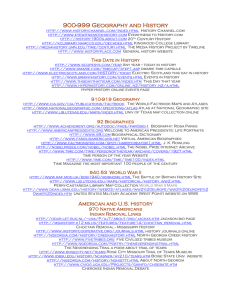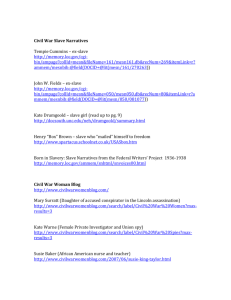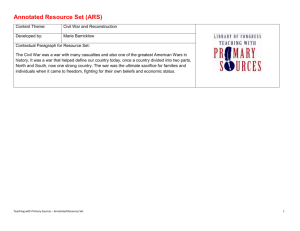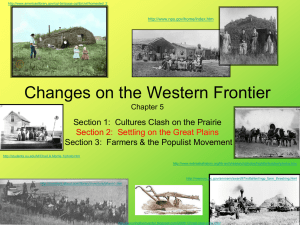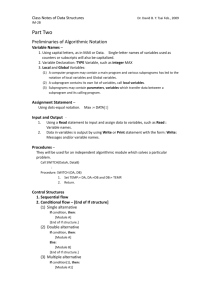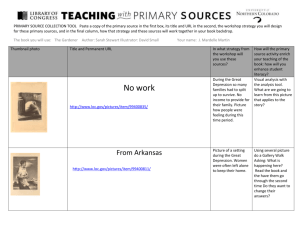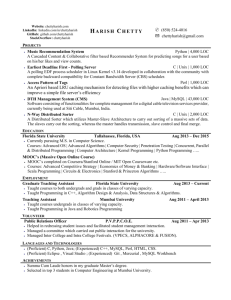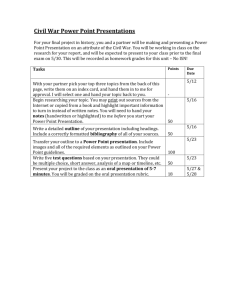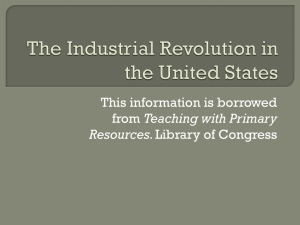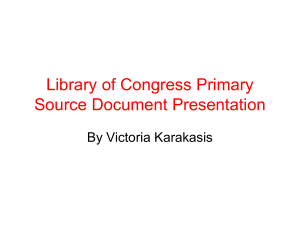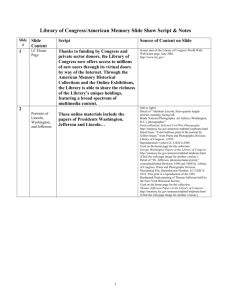Resource Set
advertisement
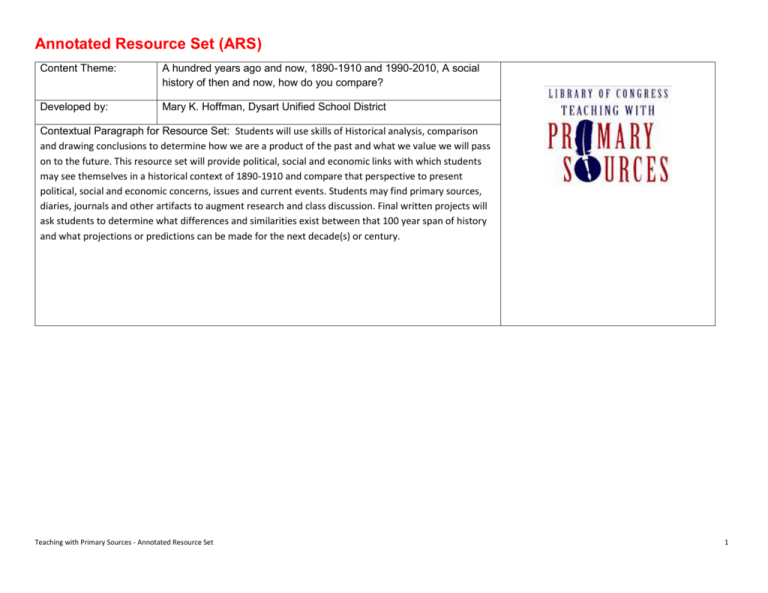
Annotated Resource Set (ARS) Content Theme: A hundred years ago and now, 1890-1910 and 1990-2010, A social history of then and now, how do you compare? Developed by: Mary K. Hoffman, Dysart Unified School District Contextual Paragraph for Resource Set: Students will use skills of Historical analysis, comparison and drawing conclusions to determine how we are a product of the past and what we value we will pass on to the future. This resource set will provide political, social and economic links with which students may see themselves in a historical context of 1890-1910 and compare that perspective to present political, social and economic concerns, issues and current events. Students may find primary sources, diaries, journals and other artifacts to augment research and class discussion. Final written projects will ask students to determine what differences and similarities exist between that 100 year span of history and what projections or predictions can be made for the next decade(s) or century. Teaching with Primary Sources - Annotated Resource Set 1 Resource Set Time Line for African American Facts and Statistics 1890-1910 Working Conditions at Westinghouse,1904 Collection of Pictures of San Francisco Earthquake Excellent Article on Working conditions in a Progressive Factory. Before and after compare to efforts after Hurricane Katrina http://memory.loc.gov/ ammem/papr/west/wes tcond.html http://memory.loc.gov/ ammem/papr/sfhome.h tml Touring -turn of the century America in photographs. (From the Learning page with teacher suggestions) Notes on beginnings of American Animation Panoramic Map Collection Visual technology innovations and trends to 1929Excellent to compare new technologies now and then Written background materials Dates and timelines http://memory.loc.gov/ ammem/aap/timelin3.h tml Teaching with Primary Sources - Annotated Resource Set http://memory.loc.gov/ ammem/ndlpedu/collec tions/detroit/history.ht ml http://memory.loc.gov/ ammem/oahtml/oapres .html (http://memory.loc.go v/ammem/pmhtml/pa nhome.html 2 New York City at the Turn of the Century Immigrant documents Collections (From the Learning Page) (http://memory.loc.gov/ ammem/ndlpedu/collec tions/nyfilm/history.ht ml http://sunsite.berkeley. edu/cgibin/flipomatic/cic/brk53 22 Teaching with Primary Sources - Annotated Resource Set “ I have been sitting in an cafeteria, letter from immigrant, impressions” http://memory.loc.gov/ mss/wpalh2/23/2306/2 3060406/23060403.tif Photographs from Chicago Daily News Turn of Century Collection (http://memory.loc.gov/ ammem/ndlpcoop/ichih tml/caption.html American At Work America At School 1894-1915 Collection of Videos of school practices turn of the 20th century Collection of Video and summaries http://memory.loc.gov/ cgibin/query/r?ammem/pa pr:@filreq(@field(NUM BER+@band(awal+0865 ))+@field(COLLID+workl eis)) http://memory.loc.gov /ammem/awlhtml/awl scho.html 3 Notes/Comments: Please note this set may be used in a 7th and 8th grade curriculum but also applicable to US History and Arizona History on the 11th grade level. Further notations for an Arizona Historical component will be added. The resources included represent no only single site resources but collections of primary resources so that teachers may choose from a variety of resources from within a particular collection. In addition, Links have been provided to the Learning Page collections which also provide not only US History Sites specific to a topic but also links to critical thinking and historical analysis. It is hoped that teachers would not only use this resource set, but share and also refine it to a better product. Teaching with Primary Sources - Annotated Resource Set 4 Resource Set American At Leisure Collection of videos and stories at turn of century. Presidential Oath of Office Link to compare inaugural speeches of William Taft (1909) and Barack Obama (2009)for comparison of message sent by President to world leaders. Each president recites the following oath, in accordance with Article II, Section I of the U.S. Constitution: "I do solemnly swear (or affirm) that I will faithfully execute the office of President of the United States, and will to the best of my ability, preserve, protect and defend the Constitution of the United States." http://memory.loc.gov/ ammem/awlhtml/awllei s.html http://memory.loc.gov/ ammem/pihtml/pioaths .html Interviews with Today’s immigrants, from the Learning Page, links to most current immigrant experience. Great America Potluck Origins of American regional foods by ethnic roots and backgrounds. From the Learning Page possible extension activity American Women Collection (Resource Title Here) Manuscript Division Labor and Progressive Reform Resource for Labor leaders and issues turn of century (To view a project select the appropriate region of the world from the following menu. Click “show me,” then select the specific interview you wish to see.) Researcher can select from regions of the world for interviews, most current. http://memory.loc.gov/l earn/features/immig/int erv/toc. http://memory.loc.gov/l earn/features/immig/ck bk/index.html http://memory.loc.gov/ ammem/awhhtml/awm ss5/trade_reform.html (Resource Link Here) Notes/Comments: Teaching with Primary Sources - Annotated Resource Set 5 Annotations Grade Level Curriculum Connections Curriculum Standards Learning Objectives Content Objectives 7th grade Social Studies American History Concept 7: Emergence of the Modern United States, 1875-1929 SS07- S1C1 - 01 SS07 –S1C1-02 Students will compare and contrast populationdata in order to draw conclusions and determine similarities. Students will read and interpret primary source documents to determine point of view and evaluate strength of arguments. SS07 – S1C1 -03 Discuss how the Industrial Revolution in the United States was supported by multiple factors (i.e. geographic security, abundant natural resources, innovation in technology, available labor, global markets.) Students will use research tools to collect information of current issues and be able to draw parallels with past influences and factors that both influenced and influences both the Industrial and Information age (post industrial revolution in the United States. SS07 – S1C1 -05 Analyze the impact of industrialization on the United States.(a. rural to urban migration, factory conditions, unions, influence of big business) Students will use both cartographic and demographic information to visually show population trends from 1900 1910 to 2000-2010. Describe the innovations of the Industrial Revolution(e.g. manufacturing, textiles, transportant, improvements) Students will use past data to propose predictions about current and future trends. SS07 – S1C1 – 07 US/ AZ History for High School SS07 – S1C1-08 Reading Describe how the United States was positively and negatively affected by factors and events resulting from the arrival of large numbers of immigrants Identify the following groups’ contributions to the changing social and political structures of the United States. SS07- S1C1-10 Analyze the expanding role of the US in the world during the late 19th and early 20th century. Comprehending Informational Text Identify, analyze and apply knowledge of purpose, structures, clarity and relevancy of functional texts. Concept 2 Concept 3 Teaching with Primary Sources - Annotated Resource Set Explain basic elements of argument in texts and their relationship to author’s purpose and us of persuasive strategies Suggested Assessment Strategies Students will determine what influences population growth and stability today and study the trends of population growth in the past. Students will compare statistical data and present findings to class. Class as whole will draw conclusions from which comparative analysis will be made with the artifacts given later. Interpretation of graphs, tables and charts, and maps. Students will demonstrate what constitutes a tend, a pattern and significant change by showing a data sources both current and related to 1900-1910. Thinking Objectives Emergence of the Modern United States1875-1929 Examine the reasons why people emigrated from their homelands to settle in the United States. Suggested Learning Strategies Students will read primary source documents concentrating on diary and journal entries from immigrants to US in 1900 and in 2000 to determine similarities and differences in immigrant experiences, influences and acculturation. Similarly students will study what modern industrial parks are like, perhaps by field study of local area and compare working conditions by surveying workers today and comparing that with research on working conditions of the past. Students may interview a local labor leader, legislator or lobbyist or related health care official to determine what would be the needs of modern workers and compare that to the needs of workers in the early 1900/s. Students would compare maps of their community in 1900 to current maps and explain the change in land use and demographics. Students may analyze and evaluate the American foreign policy position and view of US role in 1909 and 2009 Student will submit an essay on their interpretation of the historical significance of the early 1900’s on the life in the US as we now experience it. Students will choose an area of focus and include reference of research which supports their conclusions.(We are a product of the past and what is valued is passed on to the future.) Links to Other Resources US Statistical Abstracts.http://www. census.gov/compendi a/statab/ US. Department of Labor, http://www.dol.gov/ US Department of Commerce, http://www.commerc e.gov/OS/index.htm www.randmcnallyclass room.com Students will submit a recommendation for improvement of a current work situation as based upon local research and show its parallel to the working conditions of the past. Students will draw conclusions based up analysis of current and past data by using maps, charts and graphs. Student compare the inaugural addresses of William Howard Taft in March of 1909 and that of Barack Obama in 2009 as http://projects.washin gtonpost.com/staff/ar ticles/jay+mathews/ (articles on 21st century skills needed ) 6
